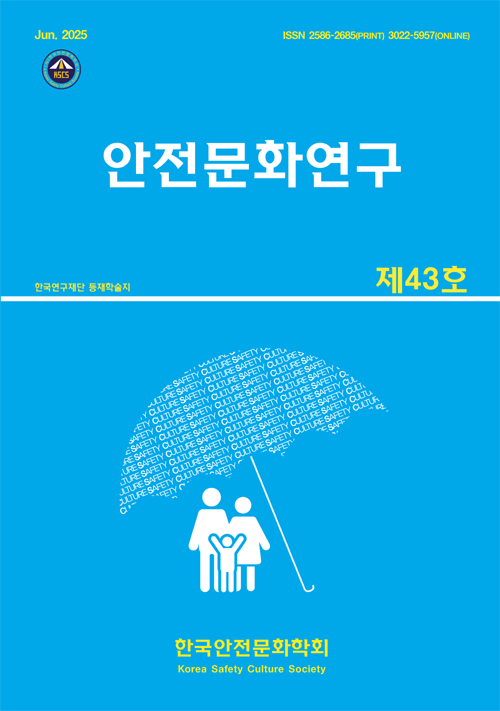- 영문명
- Why Do Older Adults Drive? : A Focus on Driving Motivations in Later Life and Policy Implications
- 발행기관
- 사단법인 한국안전문화학회
- 저자명
- 최문정(Moon Jeong Choi)
- 간행물 정보
- 『안전문화연구』제43호, 97~107쪽, 전체 11쪽
- 주제분류
- 사회과학 > 사회과학일반
- 파일형태
- 발행일자
- 2025.06.30
4,120원
구매일시로부터 72시간 이내에 다운로드 가능합니다.
이 학술논문 정보는 (주)교보문고와 각 발행기관 사이에 저작물 이용 계약이 체결된 것으로, 교보문고를 통해 제공되고 있습니다.

국문 초록
본 연구는 고령자의 운전동기를 유형화하고, 각 유형에 따른 인구사회학적·환경적 특성을 분석하는 것을 목표로 한다. 연구데이터는 2019년에 전국 17개 시도의 만 65세 이상 노인을 모집단으로 비례층화할당 추출한 표본을 대상으로 한 설문조사데이터를 활용하였다(표본크기: 1,500명). 운전상태는 유효한 운전면허 보유 및 최근 한 달간 운전 여부를 기준으로 판단하였다. 운전 지속 이유에 따라 운전동기를 다음 네 가지 유형으로 구분하였다: ①생계를 위해(운전기사로 일함), ②대중교통 접근이 어려워서(농촌 또는 도심 외곽에 거주), ③개인승용차 이동이 편리한 가족을 돌보기 위해, ④생필품 구매 편리를 위해(대형마트 등 방문). 데이터에 모집단 일반화를 위한 가중치를 적용하였으며, 운전동기를 종속변수로 다항로지스틱 회귀분석을 실시하였다. 응답자의 24.4%가 현재 운전 중이며, 주요 운전동기로는 편리를 위해(44.5%), 가족을 돌보기 위해(34.5%), 대중교통 접근의 어려움 때문에(13.5%), 생계를 위해(7.5%) 운전한다는 응답이 많았다. 가족을 돌보기 위해 운전하는 고령자는 거의 대부분(99.3%)이 기혼으로 유배우자와 함께 거주하고 있었으며, 남성일 가능성이 높았다. 다항로지스틱 회귀분석결과, ‘편의를 위해’ 운전하는 집단에 비해 ‘가족 돌봄을 위해’ 운전하는 고령자는 생필품 구매를 위한 이동에 도보로 10분 이상 소요되는 환경에 거주할 가능성이 1.97배 높았다(OR = 1.97, 95% CI = 1.08-3.59). 또한 ‘대중교통 접근 어려움’ 유형 역시 생필품 구매처나 노인복지관까지 거리가 먼 환경에 거주할 확률이 높았으며, 농어촌 지역에 거주하는 비율도 상대적으로 높았다. 본 연구는 노년기의 운전이 단순히 이동 편의성 차원을 넘어, 가족돌봄이나 생계유지 등 가족 내 역할 수행과 일상생활을 위한 필수활동으로서의 의미를 지니고 있음을 보여준다. 고령운전자에 대한 정책적 개입은 이러한 운전동기의 유형을 고려하여, 이동요구(mobility needs)를 충족할 수 있는 대체교통수단과 돌봄지원체계 마련을 포함하는 통합적 접근으로 이루어질 필요가 있다.
영문 초록
This study aims to categorize the motivations behind older adults' driving behaviors and examine how these motivations are associated with sociodemographic and residential environmental factors. Data were collected through a nationally representative survey of 1,500 adults aged 65 and older in Korea, stratified by gender, age group, and region across 17 regions. Driving status was defined as holding a valid driver’s license and having driven within the past month. Respondents’ reasons for driving were classified into four categories: (a) for a living (commercial drivers), (b) due to limited access to public transportation (typically in rural or suburban areas), (c) to provide care for a family member, and (d) for convenient grocery shopping. Sampling weights were applied to ensure generalizability, and a multinomial logistic regression model was used to analyze the data. Approximately 24.4% of respondents reported currently driving. Their primary motivations were: convenience (44.5%), caregiving (34.5%), lack of public transportation (13.5%), and livelihood (7.5%). Notably, nearly all caregiving drivers (99.3%) were married men living with a spouse. The regression analysis revealed that caregiving drivers were significantly more likely to live in areas where it takes over 10 minutes to walk to a grocery store, compared to those driving for convenience (OR = 1.97, 95% CI: 1.08–3.59). Similarly, those who drove due to insufficient public transportation were more likely to reside in rural areas far from grocery stores and senior centers. These findings indicate that older adults' decisions to drive are shaped by factors beyond personal convenience; many drive to meet caregiving responsibilities or make a living. Therefore, policies targeting older drivers should account for these diverse motivations and consider implementing alternative transportation options and caregiving support systems tailored to the varied mobility needs of older adults.
목차
Ⅰ. 서 론
Ⅱ. 연구방법
Ⅲ. 연구결과
Ⅳ. 결론 및 제언
참고문헌
해당간행물 수록 논문
- 거짓말 여부와 의사소통 방식이 진술 전략에 미치는 영향 - 비네트 설문을 활용한 한일 비교연구
- SIF 데이터를 활용한 건설업 사망사고의 공정별 사고 발생영역 분석 - 건물 건설공사를 중심으로
- VR 기반 건설안전교육콘텐츠의 평가모델에 대한 탐색적 연구
- 간호대학생의 돌봄 효능감 향상 교육의 효과
- 간호사의 전문심장소생술 수행의도 및 관련 요인
- 배달 이륜자동차 위험운전 행동 유형 및 인식에 관한 연구
- 산업장 근로자의 직무 스트레스 및 건강증진행위가 여가만족도에 미치는 영향
- 시뮬레이션기반 낙상 교육프로그램이 신규간호사의 낙상에 대한 지식, 태도, 문제해결능력에 미치는 효과
- 중노년층의 사회자본이 지역사회 의료서비스 만족에 미치는 영향 - 1·2차 베이비부머를 대상으로 한 다층모형 분석
- 청년 정신장애인의 사회적 고립 예방을 위한 서비스제공자의 사업수행 경험 연구 - 일 기관의 서비스제공자를 중심으로
- 지역사회기반 산전관리프로그램이 임부의 임신건강관리 자기효능감, 태아애착, 우울에 미치는 효과
- 해양경찰구급대 확대를 위한 시뮬레이션 기반의 현장형 2급 응급구조사 양성 교육의 효과 분석
- 반도체 설비 유지보수작업자의 작업환경관리체계와 올바른 호흡보호구 착용의 관계에서 호흡보호구 지식수준의 매개효과
- 국방 인공지능 무기체계의 위험성 평가측정지표 개발 실증연구 - 중대급 이하의 현장 운용 요원을 중심으로
- 중년여성의 우울 중재프로그램에 관한 국내 간호연구의 통합적 고찰
- 토픽모델링을 적용한 국내 역경 관련 학술 연구의 주제 구조와 연구동향 분석
- 노인은 왜 운전하는가? - 노년기 운전 지속 동기와 정책적 함의
참고문헌
관련논문
사회과학 > 사회과학일반분야 BEST
- AI와 디지털 문화 산업의 결합에서 저작권 및 윤리적 규범 준수의 필요성 연구
- 인공지능(AI)과 윤리
- 종합병원 간호사의 환자안전문화인식과 조직의사소통만족이 안전간호활동에 미치는 영향
사회과학 > 사회과학일반분야 NEW
- 일본의 노인 삶의 보람 취로 현황 및 과제: 삶의 보람 취로에서 삶의 보람 활동으로
- 잠재프로파일 분석을 활용한 저소득 청년이 인지하는 고용장벽의 유형화
- 중장년 약물중독 회복당사자의 외로움 영향요인 연구
최근 이용한 논문
교보eBook 첫 방문을 환영 합니다!

신규가입 혜택 지급이 완료 되었습니다.
바로 사용 가능한 교보e캐시 1,000원 (유효기간 7일)
지금 바로 교보eBook의 다양한 콘텐츠를 이용해 보세요!



